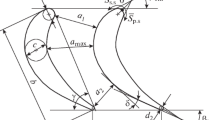Abstract
Two different nozzle cascades designed for an LP aircraft turbine have been investigated. The cascade had large convergence, a moderate curvature of the airfoils, and it flowed over so that the outlet subsonic velocity was high. It was designed for a flow inlet angle of α0 = 63.5°, an outlet angle of α1 = 28.6°, and a reduced isoentropic outlet velocity of λ1 = 0.93. Having the same width of 41 mm, the first cascade was made up of 5.9 mm thick profiles, while the second one from 4 mm thick profiles. To improve the efficiency of the second cascade, the suction side curvature near the trailing edge decreased more sharply, which yielded a smoother velocity distribution over the suction side according to the design calculation. However, calculations of a viscous flow in the second cascade revealed no tendency towards a decrease in the profile losses. The experiments demonstrated that both cascades featured a high efficiency on the ranges of λ1 = 0.80–0.98 and α0 = 52°–69°. It is important that the design mode with respect to λ1 coincided with the mode giving the lowest energy losses. The first cascade from thicker profiles was more efficient than the second cascade where, with the same overexpansion of the flow on the suction side, the critical velocity was attained just downstream of the throat while it was shifted to the trailing edge in the first cascade. A slight flow deceleration on the suction side did not result in a local velocity equal to the velocity downstream of the cascade, and a flow separation occurred near the trailing edge at λ1 ≥ 0.93. It is these features of the flow in the second cascade that are responsible for an increase in the profile loss coefficient by 0.26% under the design operating condition.
Similar content being viewed by others
References
B. I. Kurmanov and G. L. Podvidz, “Calculating the flow in turbomachine cascades on the basis of Navier–Stocks equations using the mathematical turbulence model (q−ω),” Uch. Zap. TsAGI 32 (3–4), 81–95 (2001).
M. E. Deich, Gas Dynamics of Turbomachine Cascades (Energoatomizdat, Moscow, 1996) [in Russian].
E. V. Maiorskii and B. I. Mamaev, “Aerodynamic development and investigation of turbine transonic rotor blade cascades,” Therm. Eng. 62, 329–334 (2015). doi 10.1134/S0040601515050080
V. D. Venediktov, A. V. Granovskii, A. N. Karelin, A. N. Kolesov, and M. Kh. Mukhtarov, Atlas of Experimental Characteristics of Flat Lattices of Cooled Gas Turbines (TsIAM, Moscow, 1990) [in Russian].
M. Ya. Ivanov and R. Z. Nigmatullin, “S.K. Godunov’s implicit high-accuracy scheme for the numerical integration of Euler’s equations,” USSR Comput. Math. Math. Phys. 27, 1725–1735 (1987).
Author information
Authors and Affiliations
Corresponding author
Additional information
Original Russian Text © B.I. Mamaev, 2018, published in Teploenergetika.
Rights and permissions
About this article
Cite this article
Mamaev, B.I. Investigation of Nozzle Cascades of a Turbine Stage. Therm. Eng. 65, 482–486 (2018). https://doi.org/10.1134/S0040601518070042
Received:
Accepted:
Published:
Issue Date:
DOI: https://doi.org/10.1134/S0040601518070042



